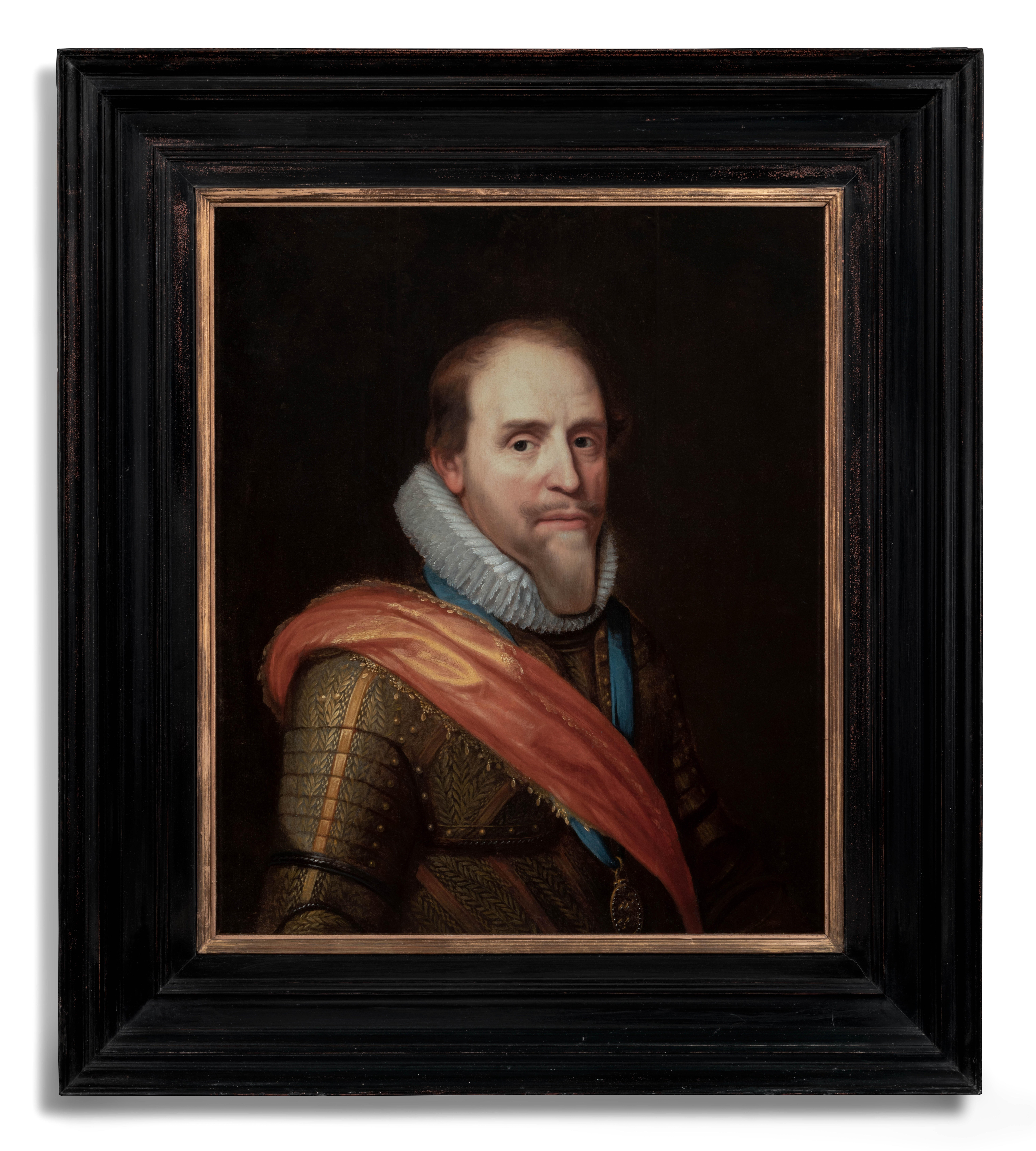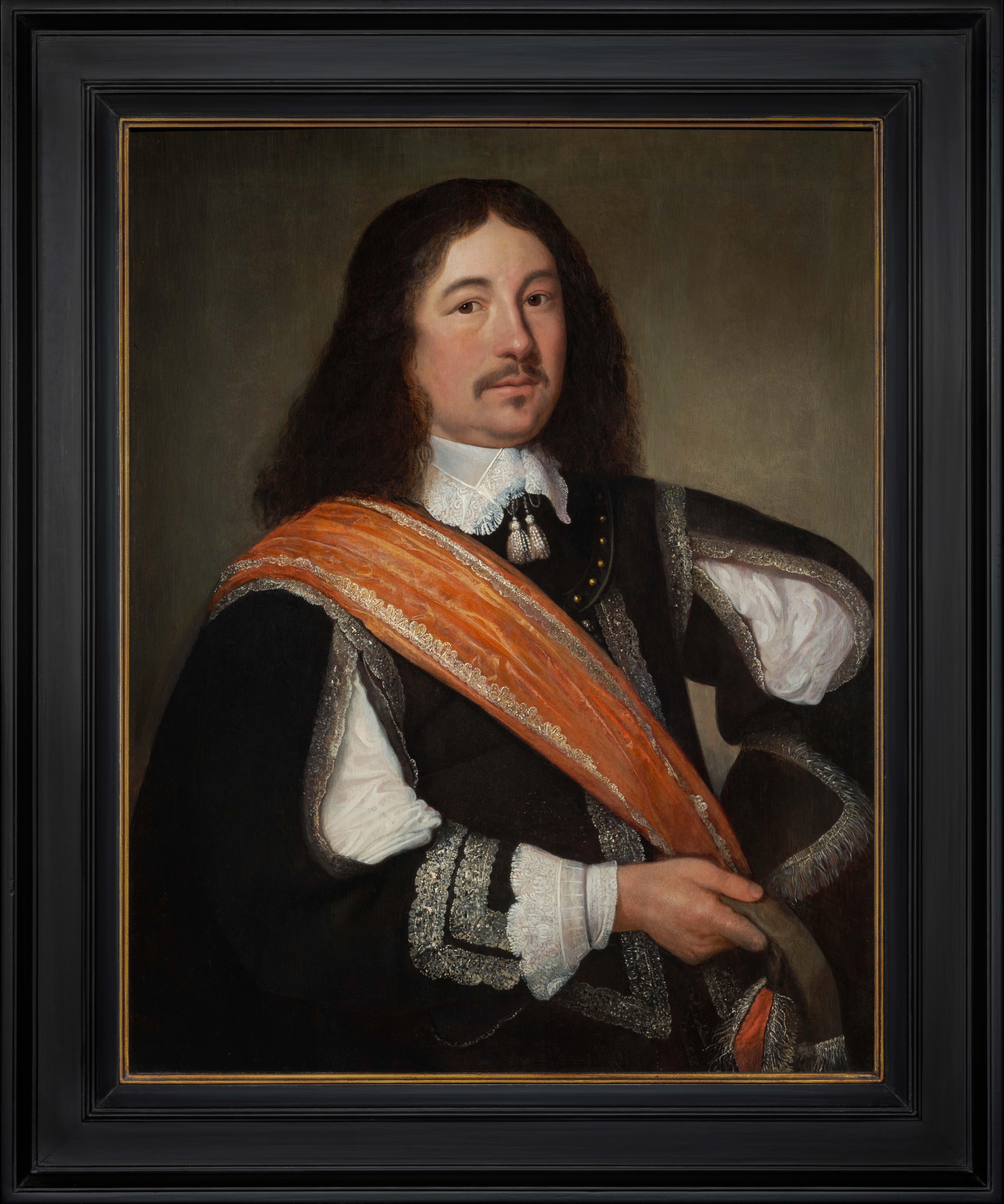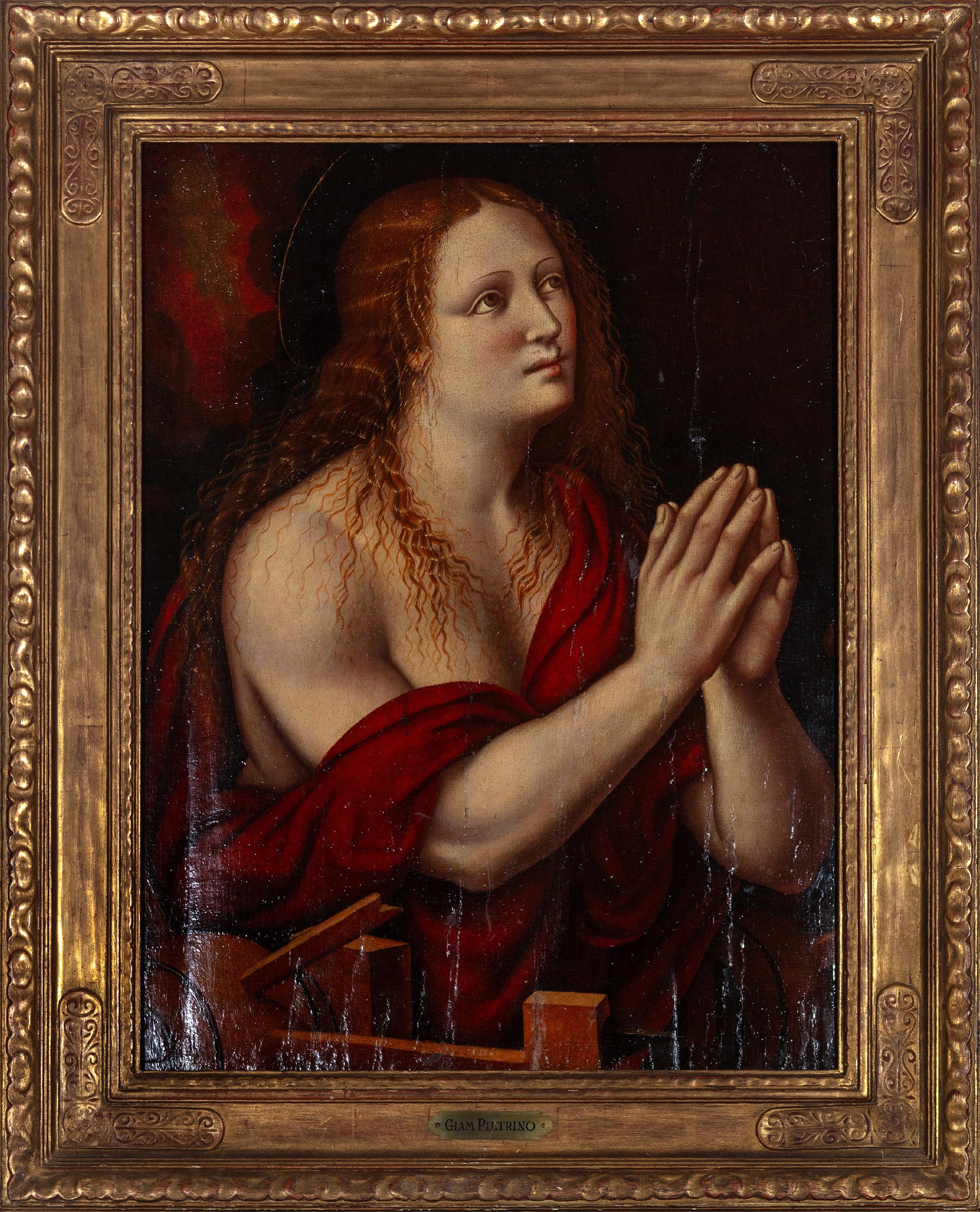Items Similar to Man in Tavern Smoking a Pipe /// Old Masters Dutch David Teniers Portrait Face
Want more images or videos?
Request additional images or videos from the seller
1 of 14
Man in Tavern Smoking a Pipe /// Old Masters Dutch David Teniers Portrait FaceCirca: 1690
Circa: 1690
About the Item
Artist: Unknown (Circle of David Teniers the Younger, Flemish, 1610-1690)
Title: "Man in Tavern Smoking a Pipe"
*No signature found
Circa: 1690
Medium: Original Oil Painting on Wooden Board
Framing: Framed in an antique gold gesso frame
Framed size: 10" x 9"
Board size: 6" x 4.88"
Condition: Cosmetic wear to framing. The painting is in very good condition
Notes:
Provenance: private collection - Cleveland, OH. Red wax seal with unidentified collector's mark resembling a bird perched on a branch on verso.
Biography:
David Teniers the Younger (1610-1690) was a 17th-century Flemish painter known for his luminous depictions of peasant life. His work was greatly influenced by the tavern scenes of Adriaen Brouwer and the fluid paint handling of Peter Paul Rubens. Born on December 15, 1610 in Antwerp, Belgium, he was the son of the artist David Teniers the Elder, with whom he studied as a youth. Notably, Teniers later married the daughter of the painter Jan Brueghel the Elder. In the early 1630s, the Haarlem-based painter Brouwer moved to Antwerp, Teniers exposure to his low-genre paintings was a turning point in his career. Over the following decades, he enjoyed a popular reputation around Europe. Though most of his works were modest in scale, he was a prolific artist and is thought to have completed some 2,000 paintings over the course of his career. Teniers died on April 25, 1690 in Brussels, Belgium. Today, his work can be found in the Louvre in Paris, the National Gallery of Art in London, the Hermitage Museum in St. Petersburg, and the Rijksmuseum in Amsterdam, among others.
- Creation Year:Circa: 1690
- Dimensions:Height: 10 in (25.4 cm)Width: 9 in (22.86 cm)
- Medium:
- Movement & Style:
- Circle Of:David Teniers the Younger (1610 - 1690, Flemish)
- Period:1690-1699
- Condition:(Very Good).
- Gallery Location:Saint Augustine, FL
- Reference Number:1stDibs: LU121210063252
About the Seller
5.0
Platinum Seller
These expertly vetted sellers are 1stDibs' most experienced sellers and are rated highest by our customers.
Established in 1978
1stDibs seller since 2015
1,222 sales on 1stDibs
Typical response time: <1 hour
- ShippingRetrieving quote...Ships From: Saint Augustine, FL
- Return PolicyA return for this item may be initiated within 3 days of delivery.
More From This SellerView All
- Cowboy /// Contemporary Pop Portrait Painting Funny Man Sheriff Dan May AmericanBy Dan MayLocated in Saint Augustine, FLArtist: Dan May (American, 1955-) Title: "Cowboy" *Signed by May upper right Circa: 2020 Medium: Original Acrylic Painting on Board Framing: Framed in a contemporary black moulding F...Category
2010s Contemporary Portrait Paintings
MaterialsPaint, Acrylic, Wood Panel, Board, Panel
- Portrait of Margaritta MacDonald in red jacket and white gown (half-length)By Sir Henry RaeburnLocated in Saint Augustine, FLArtist: (after) Sir Henry Raeburn (Scottish, 1756-1823) Title: "Portrait of Margaritta MacDonald in red jacket and white gown (half-length)" *No signature found Circa: 1820 Medium: O...Category
1820s Baroque Portrait Paintings
MaterialsCanvas, Paint, Oil, Gesso
- Criminal #23 /// Contemporary Pop Art Painting Jail Prisoner Funny Bandit FigureBy Dan MayLocated in Saint Augustine, FLArtist: Dan May (American, 1955-) Title: "Criminal #23" *Signed by May lower left. It is also signed on verso Year: 2018 Medium: Original Acrylic Painting on C...Category
2010s Contemporary Portrait Paintings
MaterialsCanvas, Paint, Acrylic, Board
- Dutch Fishing Vessels in Storm /// Francis Swaine Maritime Seascape Antique ShipBy Francis SwaineLocated in Saint Augustine, FLArtist: Francis Swaine (English, 1725-1782) Title: "Dutch Fishing Vessels in Storm" *No signature found Circa: 1770 Medium: Original Oil Painting on wood panel Framing: Framed in a Louis XV style gold moulding Framed size: 10.63" x 12.63" Panel size (irregular margins): 6" x 7.75" Condition: One small restored spot upper left. Cosmetic wear to frame. In otherwise very good condition Notes: Provenance: private collection - London, England; acquired from art dealer Ernest Alden, London, England retaining his original gallery label on verso. Metal plaque inscribed "F. Swaine 1740-1782", (active dates), attached to frame bottom center. Ernest William Alden (1866-1947) was recorded in successive censuses, in 1881 as a picture mounter (card maker), age 14, living at 9 Bloomsbury St, with several other members of his family also given as picture mounters, including his father, James; in 1891 as a picture frame mounter with his father and family at 208 Shaftesbury Avenue; in 1901 as a photographer and picture dealer at 39 King’s Road, Chelsea; and in 1911 again at 39 King’s Road but the census form is damaged. His listing in trade directories, initially as picture mount cutter, changed to picture framemaker from 1904, soon after he set up in the King’s Road. He advertised his large stock of second-hand swept and other frames, claiming to have been established in 1893 (The Year’s Art 1913). Alden died in Chelsea in 1947, leaving effects worth £5,011, with probate granted to his widow Lily Alden and to Marjorie Frances Alden. Two of his younger brothers, Henry Cyril Alden (1871-1939) and James Preston Alden (1876-1960), were also active as picture framemakers. - National Portrait Gallery, London, England. Biography: Francis Swaine (1725–1782) was a British marine painter. He was born in 1725, and christened on 7 October of that year at St Dunstan's, Stepney, London. His parents were named Francis Swaine and Ann Joel. In 1735 the elder Francis Swaine, the marine painter's father, applied in writing to the Commissioners of His Majesty's Navy for employment as a Navy Messenger, in succession to Mr William Wyatt. He mentions that he had served "upwards of twenty eight years" in the Navy, and that his father had died Purser of the Royal Katherine. He mentions also that he had carried out "little labours in drawing", and that he at that time had five small children. The first-born of these children was the Francis Swaine who became the marine painter. The elder Swaine was duly employed as a Navy Messenger. He served for 20 years and died on 10 October 1755, aged 64. Swaine is said to have been influenced by the style of Van de Velde. There is no clear evidence of this alleged influence. The suggestion that Swaine may have been a pupil of Charles Brooking...Category
1770s Old Masters Landscape Paintings
MaterialsPaint, Oil, Panel, Wood Panel, Board
- Lee Miller Icon II (Man Ray) /// Huge Contemporary Street Pop Art Painting ModelBy Jack Graves IIILocated in Saint Augustine, FLArtist: Jack Graves III (American, 1988-) Title: "Lee Miller Icon II (Man Ray)" Series: Icon *Signed by Graves lower left. It is also signed, titled, and dated on verso Year: 2024 ...Category
2010s Contemporary Portrait Paintings
MaterialsCanvas, Paint, Acrylic
- Elizabeth Taylor Icon VIII /// Contemporary Street Pop Art Actress Fashion ModelBy Jack Graves IIILocated in Saint Augustine, FLArtist: Jack Graves III (American, 1988-) Title: "Elizabeth Taylor Icon VIII" Series: Icon *Signed by Graves lower right. It is also signed, titled, and dated on verso Year: 2022 Me...Category
2010s Contemporary Portrait Paintings
MaterialsAcrylic, Canvas, Paint
You May Also Like
- Portrait of Gentleman, Thomas Bruce, Earl of Elgin c.1638 Manor House ProvenanceLocated in London, GBTitan Fine Art present this picture which formed part of a historic collection of an English aristocratic family, Lord and Lady Sandys at their magnificent baroque and Regency Grade-...Category
17th Century Old Masters Portrait Paintings
MaterialsOil, Wood Panel
- Portrait of a Lady Diana Cecil, Countess of Elgin c.1638, Manor House ProvenanceLocated in London, GBTitan Fine Art present this picture which formed part of a historic collection of an English aristocratic family, Lord and Lady Sandys at their magnificent baroque and Regency Grade-...Category
17th Century Old Masters Portrait Paintings
MaterialsOil, Wood Panel
- 18th century portrait of the painter Nathaniel DanceLocated in London, GBCollections: Robert Gallon (1845-1925); Private Collection, UK. Oil on canvas laid down on panel Framed dimensions: 11.5 x 10 inches This highly engaging, previously unpublished portrait by Johan...Category
18th Century Old Masters Portrait Paintings
MaterialsOil, Wood Panel, Canvas
- Dutch Old Master Portrait of Maurits, Prince of Orange-Nassau, Oil on PanelLocated in London, GBIn 1607, the Delft city council decided to commission a portrait of Stadholder Maurits of Nassau for the town hall, with Michiel van Mierevelt as the chosen artist due to the passing...Category
17th Century Old Masters Portrait Paintings
MaterialsOil, Wood Panel
- Portrait Gentleman Black Coat Orange Sash, Dutch Old Master, Oil on Panel c.1650By Bartholomeus van der HelstLocated in London, GBThis exquisite portrait of a gentleman depicted in a sumptuous black coat edged with silver and slashed sleeves is an excellent example of the type of portrait fashionable in England and the Low Countries during the 17th century. The confident pose, striking orange sash - the colour of the house of Orange Nassau - and the leather gorget imbue the sitter with a sense of masculinity and power. The profusely decorated costume is of the highest quality and de rigueur of an elite class - the artist has carefully cultivated this portrait to emphasise the sitter’s wealth and standing in the society that he belonged to. The casual pose, with one arm resting on a hip, is much less formal than earlier decades, and it speaks of ‘sprezzatura’ – one’s appearance should not appear laborious, but instead, effortless. The oil on cradled panel portrait can be dated to circa 1650 based on the hairstyle and the attire - small falling collar, short doublet (doublets reduced in size to just below the ribcage in the late 1650’s), and the type of slashed sleeves with the sleeve seams left open to reveal the white fabric. The demand for portraits in the Netherlands was great in the 17th century. Bartholemeus van der Helst was considered to be one of the leading portrait painters of the Dutch Golden Age surpassing even Rembrandt as the most sought-after portraitist in Harlaam. The Dutch Golden Age, roughly spanning the 17th century, was a period when Dutch trade, science, military, and art were among the most acclaimed in the world. Dutch explorers charted new territory and settled abroad. Trade by the Dutch East-India Company thrived, and war heroes from the naval battles were decorated and became national heroes. During this time, The Dutch Old Masters began to prevail in the art world, creating a depth of realistic portraits of people and life in the area that has hardly been surpassed. The Golden Age painters depicted the scenes that their discerning new middle-class patrons wanted to see. This new wealth from merchant activities and exploration combined with a lack of church patronage, shifted art subjects away from biblical genres. Still life’s of items of everyday objects, landscapes, and seascapes reflecting the naval and trade power that the Republic enjoyed were popular. The new wealthy class were keen to have their portraits commissioned and many artists worked in this lucrative field. Such was the popularity of art that everyone had a painting, even the humble butcher, and hundreds of thousands of paintings were produced. By tradition the sitter is Maarten Tromp (1598-1653) who was an Admiral in the Dutch Navy (the reverse of the portrait contains an old handwritten inscription “van Tromp”). Certainly, the distinctive orange sash is similar to those worn by officers of the Dutch army in the Netherlands who served under the Princes of Orange and the House of Nassau. However, it should be noted that the physiognomy differs from other images of Tromp. Tromp was the oldest son of Harpert Maertensz, a naval officer and captain. He joined the Dutch navy as a lieutenant in July 1622 and was later promoted from captain to Lieutenant-Admiral of Holland and West Frisia in 1637. In 1639, during the Dutch struggle for independence from Spain, Tromp defeated a large Spanish fleet bound for Flanders at the Battle of the Downs, which marked an enormous change - the end of Spanish naval power. He was killed in action during the First Anglo-Dutch War in 1653 where he commanded the Dutch fleet in the battle of Scheveningen. Gloves were an absolutely vital accessory and the elaborate pair in this portrait are embellished with threads of silk and precious metals and salmon-coloured lining. He wears only one glove and holds the other, providing an opportunity to better display the cuffs and detail on his right wrist and forearm. The gloves are probably made from the most prized leather which came from Spain, in particular from Cordova. Cordovan leather was tanned with a special vegetal process that left it both highly impermeable and divinely soft. King Charles I, posed in a rather relaxed manner for Daniel Mytens’s portrait in 1631, is wearing gloves and boots in matching Cordovan leather. The hide is thick, but you can see just how supple it is from the way the gauntlet dimples and the long boot legs fold over themselves, rippling and wrinkling at the ankles. Apart from keeping hands warm the use of gloves during the 15th through the 19th centuries were full of symbolism and they were worn regardless of the season. They kept the skin unblemished - soft, smooth hands were considered highly attractive. This combination of necessity and proximity to bare skin made gloves a deeply personal gift and they took on a strong symbolic significance and were regarded as emblematic of fidelity and loyalty for hundreds of years. Such was the importance of their symbolism was that some gloves were never intended to be worn at all. Their luxury made them ideal gifts at court, and so in the 15th and 16th centuries, ambassadors often presented them as symbols of loyalty. Until the mid-19th century, it was customary to give gloves as tokens to guests at weddings and to mourners at funerals. Gentleman often gifted their bride-to-be with a pair of gloves (the obligatory gift) and were handed over at the betrothal and put on display before the wedding took place. It was probably their direct contact with the skin that led to the eroticism of gloves. Not only were pairs often exchanged between lovers, but from the 16th to the 18th centuries, it was common practice to remove one glove and give it as a gift to a favourite. The idea of the item being presented still warm from the wearer’s hand is certainly suggestive. Following the death of King George IV, his executors purportedly found over a thousand mismatched ladies’ gloves among his possessions. The sentiment of a 17th-century poem reveals the popularity of the practice: “Come to our wedding to requite your loves / Shew us your hands and we’ll fit you with gloves.” Such generosity might be pricey for the hosts, but gloves of varying quality could be offered depending on the status of the recipient. Pairs made with the finest Spanish leather might be reserved for immediate family, while coarse sheep’s leather could be distributed among the servants and tradesmen. The apportioning of quality according to class provided a very clear message of the gloves’ intended use. For refined guests, they were decoration; for the lower classes, they were functional. Bartholomeus van der Helst...Category
17th Century Old Masters Portrait Paintings
MaterialsOil, Wood Panel
- "Caterina d'Alexandria (Saint Catherine of Alexandria)" classical religiousBy (After) GiampietrinoLocated in Milwaukee, WI"Caterina d'Alexandria (Saint Catherine of Alexandria)" is an original oil painting on wood panel, likely painted by Italian artist Giampietrino (Giovanni Pietro Rizzoli). The painti...Category
19th Century Old Masters Portrait Paintings
MaterialsOil, Wood Panel
Recently Viewed
View AllMore Ways To Browse
Master Of The Die
Antique Face Art
Frame Face Portrait
Portrait Of Black Man
Portrait Of A Black Man
Old Master Portrait
Belgian Master
Son Of A Man
Portrait Belgium
Man With A Bird
Gold Black Face
Black Face Antique
Portrait Old Man
Framed Dutch Portraits
Oil Portrait Old Master
Portrait Of An Old Man
Antique Portrait Painting Of Man
Dutch Title





